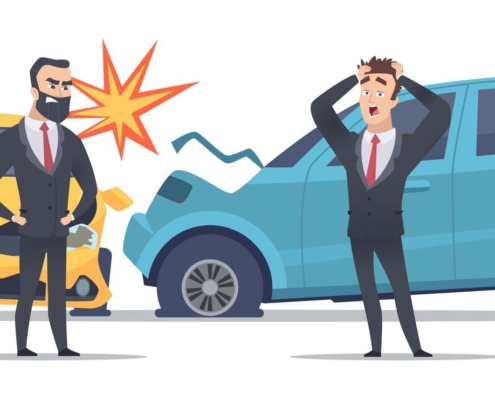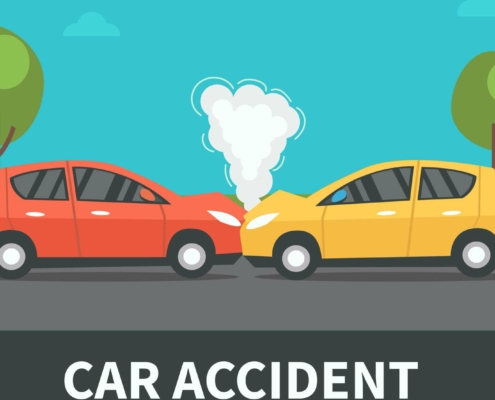Will a hit and run claim raise my insurance?
No, if you’re not at fault in the hit and run, the car insurance company cannot raise your insurance rate. But if you’re at fault in a hit-and-run car accident, your insurance many raise the insurance rate.
By Brad Nakase, Attorney
Email | Call (888) 600-8654
Get Smarter: Search my blogs
Will my insurance rates go up after an accident that was not my fault?
When it comes to car accidents, especially those that are not caused by a policyholder, many would expect their insurance rates to remain unchanged. However, the reality is often far from this expectation, with insurance companies frequently raising premiums even after accidents that were not the fault of the insured. This practice has been met with increasing discontent, leading to crucial legislative changes in certain jurisdictions.
California, known for its progressive legal landscape, has taken a definitive stance on this issue. Recognizing the unfairness imposed upon policyholders who find themselves victims of circumstances beyond their control, California law prohibits insurance companies from raising premiums following accidents in which their policyholders were not at fault. This legal safeguard ensures that innocent individuals are not penalized for the actions of others, fostering a sense of justice and fairness within the insurance industry.
In this article, our auto accident attorney in San Diego will explore the specifics of California’s insurance laws, as well as the reasons behind the prohibition on premium hikes after non-fault accidents. We will examine the legal framework in place and the significance of this protective measure for policyholders as follows:
Under California Insurance Code Section 1861.02, insurance companies in California are required to use specific factors when calculating insurance premiums for private passenger vehicle coverage. These factors, as outlined in the code, include:
- Driving Safety Record: Insurers consider the policyholder’s driving safety record, including the number and severity of accidents, traffic violations, and any other relevant incidents that may indicate the insured individual’s level of risk.
- Years of Driving Experience: The number of years a driver has been licensed and actively driving is taken into account. Generally, more driving experience is seen as an advantage and may lead to lower premiums.
- Annual Mileage: The annual mileage driven by the insured individual is considered. Higher mileage typically corresponds to increased exposure to potential accidents and may result in higher premiums.
- Territory: The territory where the insured vehicle is primarily garaged is factored in. Certain regions may have higher or lower risk profiles, influencing the premium calculation.
- Vehicle Characteristics: The make, model, and year of the insured vehicle are taken into consideration. Factors such as the vehicle’s safety features, theft rates, repair costs, and overall risk profile play a role in determining premiums.
- Use of Vehicle: The primary use of the vehicle, whether for personal use, business use, or both, is considered. Company use may lead to higher premiums due to increased exposure to potential accidents.
- Age of Driver: The age of the insured driver is a significant factor. Younger and less experienced drivers often face higher premiums due to statistical evidence indicating a higher risk of accidents within this demographic.
It is important to note that California Insurance Code Section 1861.02 prohibits insurance companies from using certain factors to calculate premiums, including gender, marital status, and credit score. This ensures that premiums are based on factors directly related to driving risk rather than personal characteristics that are not directly associated with driving ability. Our personal injury attorney in San Diego sees average car insurance premiums increase by nearly 50% after an accident.
Insurance companies in California are required to adhere to these specific factors when determining premiums, aiming to provide a fair and transparent system that reflects the insured individual’s risk profile accurately.
What does ‘at fault’ mean in California?
According to California law, the term “principally at fault” refers to the legal concept used to determine liability or responsibility in an accident. Specifically, it is used to establish who bears the primary responsibility for causing the accident or the majority of the fault.
In California, the determination of fault in an accident is governed by the doctrine of comparative negligence. This doctrine allows for the allocation of fault among multiple parties involved in an accident. Under this principle, liability for damages is assigned based on each party’s degree of fault.
When a party is considered “principally at fault,” it means that they are deemed to bear the majority of the responsibility for causing the accident. In such cases, the party determined to be “principally at fault” will typically have a higher percentage of fault assigned to them compared to other involved parties.
It is important to note that California follows a pure comparative negligence system, which means that even if a party is found to be “principally at fault,” they may still be entitled to recover damages from other parties involved, albeit reduced in proportion to their assigned degree of fault. This system ensures that parties who are partially at fault are not entirely barred from seeking compensation for their losses.
Determining fault in an accident can be a complex process, involving investigations, evidence collection, and legal analysis. It often requires the involvement of insurance companies, legal professionals, and sometimes even courts to establish who is “principally at fault” and to apportion liability accordingly.
What kinds of accidents would be considered no-fault?
A driver may be found not at fault in various accident circumstances, depending on the specific details and evidence surrounding the incident. While each accident is unique, here are some common scenarios where a driver might be deemed not at fault:
- Rear-End Collisions: If a driver is struck from behind by another vehicle, the rear driver is typically considered at fault. The assumption is that the rear driver failed to maintain a safe distance or failed to react in a timely manner to avoid the collision.
- Left-Turn Accidents: When a driver making a left turn at an intersection is struck by an oncoming vehicle, the oncoming vehicle is often considered at fault. The driver making the left turn generally has the duty to yield to oncoming traffic, assuming the oncoming vehicle was proceeding within the speed limit and had the right of way.
- Parked Vehicle Accidents: If a parked vehicle is hit by another moving vehicle, the driver who collided with the parked vehicle is usually held at fault. The stationary vehicle was not in motion and should reasonably be expected to be given enough space.
- Sideswipe Accidents: In cases where two cars collide while driving side by side, fault can vary depending on the circumstances. However, if one vehicle unexpectedly changes lanes or merges without proper signaling or checking blind spots, that driver is often considered at fault.
- Vehicle Failure: If an accident is caused by a mechanical failure, such as a brake failure or tire blowout, the driver may be deemed not at fault. However, it is crucial to demonstrate that the driver had properly maintained the vehicle and that the failure was unforeseeable.
- Acts of Nature: Accidents caused by uncontrollable external factors, such as severe weather conditions, falling objects, or large wildlife crossing the road, typically do not assign fault to any driver involved. These incidents are considered unavoidable and not a result of the drivers’ actions.
It is important to note that fault determination can be complex and subjective, and it often requires a thorough investigation of the accident scene, witness statements, police reports, and other relevant evidence. Insurance companies, law enforcement agencies, and courts play a role in determining fault based on the available information and applicable laws.
How much do California insurance rates go up after an accident?
In California, insurance rates can increase after an at-fault accident due to several factors that influence how insurance companies assess risk and determine premiums. While specific premium increases can vary depending on the insurance provider and specific circumstances, the following are some reasons why rates may rise significantly after an at-fault accident:
- Increased Risk Profile: When an insured driver is involved in an at-fault accident, it indicates a higher likelihood of future accidents or claims. Insurance companies consider past behavior to be an indicator of future risk. As a result, they may increase premiums to compensate for the increased likelihood of paying out claims in the future.
- Loss History: At-fault accidents can result in insurance companies having to pay for repairs, medical expenses, or other damages. These costs affect the insurance company’s loss history, and higher costs can lead to increased premiums across the board to maintain profitability.
- Claim Frequency: After an at-fault accident, a driver may become more prone to file future claims, including both at-fault and non-fault accidents. Insurance companies factor in the potential for increased claim frequency when setting premiums, resulting in higher rates for drivers with a history of at-fault accidents.
- Damage Severity: The extent of damage caused by an at-fault accident can also impact premium increases. If the accident involved significant property damage, injuries, or costly repairs, insurance companies may adjust premiums accordingly to account for the potential for higher claim payouts.
- Actuarial Calculations: Insurance companies employ complex actuarial calculations and statistical models to assess risk and determine premiums. These calculations take into account a wide range of factors, including accident history, to estimate the likelihood of future claims. If the data suggests a higher risk of accidents or claims based on at-fault incidents, premiums may be adjusted accordingly.
It is always recommended for drivers to shop around for insurance quotes and compare options after an at-fault accident to find the most competitive rates available to them. Also, some insurance companies offer accident forgiveness programs or other benefits that can help mitigate premium increases for policyholders with a clean driving history before the accident.
How is fault determined after a car accident in California?
Fault determination after a car accident in California is typically based on the principles of comparative negligence. Comparative negligence is a legal doctrine that allocates fault among parties involved in an accident based on their respective degree of negligence or responsibility for causing the incident. California follows a pure comparative negligence system, meaning that even if a party is partially at fault, they can still seek compensation for damages, but the amount awarded is reduced in proportion to their assigned degree of fault.
The process of fault determination after a car accident in California involves various factors and considerations, including:
- Police Reports: Law enforcement officers who respond to the accident scene often prepare accident reports that document their observations, statements from involved parties, and any citations issued. These reports can provide valuable evidence in assessing fault.
- Statements from Witnesses: Eyewitness accounts of the accident can provide crucial information about how the incident unfolded and who may have been at fault. Witness statements are considered when determining fault.
- Traffic Laws: California traffic laws establish rules and regulations that all drivers must follow. Violations of these laws can contribute to fault determination. If a driver is found to have violated a traffic law (ex: running a red light or speeding), it can impact their liability for the accident.
- Comparative Negligence Analysis: Insurance companies, legal professionals, and sometimes courts analyze the facts and evidence of the accident to determine each party’s degree of fault. This analysis considers factors such as the actions of each driver, any contributing factors, and the overall sequence of events leading to the accident.
- Expert Opinions: In complex accident cases, experts such as accident reconstruction specialists or engineers may be consulted to provide their professional analysis and opinions on fault determination.
It is important to note that fault determination can be a complex and subjective process, as it requires a careful examination of all available evidence. Insurance companies, legal professionals, and sometimes courts review the circumstances of the accident to assign percentages of fault to each involved party. These percentages of fault impact the amount of compensation that can be sought and awarded in personal injury claims or insurance settlements.
If there is disagreement over fault allocation, parties involved in the accident may pursue legal action or engage in negotiations to reach a resolution. Consulting with a qualified attorney experienced in personal injury or car accident cases is advisable to understand the specific legal considerations and rights related to fault determination in California.
Why does percentage of fault matter in a California car accident?
The percentage of fault in a car accident matters in California due to the state’s adoption of comparative negligence laws. Comparative negligence is a legal doctrine used to allocate damages and determine the financial responsibility of each party involved in an accident. It takes into account the respective degrees of fault or negligence exhibited by each party.
Percentage of fault is significant in California for the following reasons:
- Allocation of Damages: The percentage of fault assigned to each party directly impacts how damages are allocated. In a comparative negligence system like California’s, each party is responsible for the percentage of damages equivalent to their assigned degree of fault. For example, if one driver is found 80% at fault, they would be responsible for paying 80% of the total damages.
- Recovery of Damages: The percentage of fault affects an individual’s ability to recover damages in a personal injury claim. California follows a pure comparative negligence system, which means that even if a party is partially at fault for an accident, they can still seek compensation for their injuries and losses. However, their recoverable amount will be reduced in proportion to their assigned percentage of fault. For instance, if a driver is found 20% at fault for an accident and their damages are assessed at $100,000, they would be able to recover $80,000 (80% of the total damages).
- Insurance Claims and Premiums: The percentage of fault can impact insurance claims and subsequent premium rates. Insurance companies consider fault determinations when processing claims. If a driver is assigned a high percentage of fault, it may affect their insurance coverage, potentially leading to higher premiums in the future.
- Legal Proceedings: In cases where fault is disputed, the percentage of fault becomes crucial during legal proceedings. Attorneys, insurance adjusters, and courts rely on the assigned percentages to negotiate settlements or present arguments in court. The assigned percentages influence the outcome of legal proceedings and help determine the appropriate amount of compensation.
By determining and assigning percentages of fault, California’s comparative negligence system promotes fairness and proportionality in assessing liability for accidents. It allows each party to be held accountable for their level of negligence, ensuring that individuals are responsible for the consequences of their actions to a corresponding degree.
Have a quick question? We answered nearly 2000 FAQs.
See all blogs: Business | Corporate | Employment Law
Most recent blogs:
Contact our attorney.




























